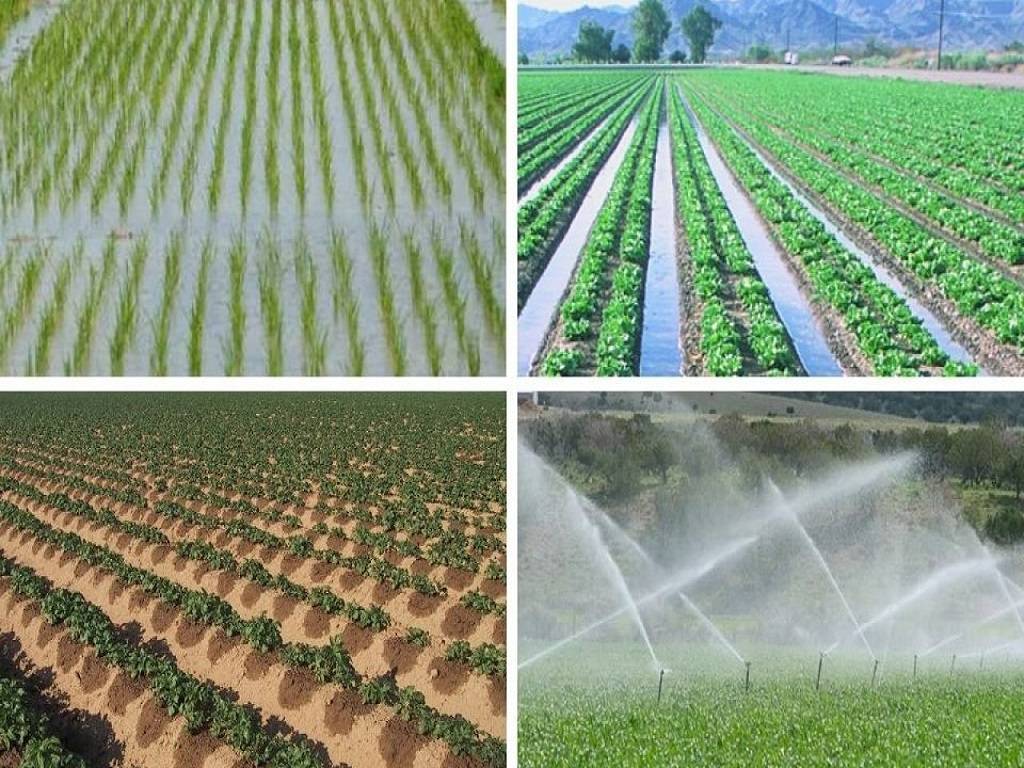
Irrigation is the process of watering crops, pastures, and plants with water that is delivered by pipes, sprinklers, canals, sprays, pumps, and other artificial features Instead of purely depending on rainfall.
In other words, it is a method for a complex watering system for assisting plants to grow because it is used as an alternative to rain-fed farming,
It is also a method of fulfilling the water requirements of plants or crops, as water is a vital resource for their growth. In addition, it helps in providing plants with the nutrients required for development and growth, as well as achieving high yields by enabling the penetration of roots in the dry. Here are the different types of irrigation:
Types of Irrigation:
Surface Irrigation
It is the most popular method of irrigation, as it only employs gravity and the land's contour to distribute water over a field, for example, in surface irrigation, water flows downhill from a higher elevation reaching all the crops.
It can only be used if the location or the ground has enough water and is naturally sloping; otherwise, it requires a lot of work. It makes use of a technique called the furrow system, in which channels are utilized to carry water down a hill over a paddock where crops or plants are cultivated, spaced about 1 meter apart.
Drip Irrigation
A sub-type of localized irrigation called drip irrigation, also known as trickle irrigation, is the delivery of very small water droplets to or near the roots of a plant.
It is a profitable method of irrigation because it reduces water runoff and evaporation. It is ideal for places with limited water supplies or high water costs and is also very suitable for all types of topography and soils. The pressure needed in drip irrigation is between 10 to 20 psi.
Sprinkler Irrigation
Sprinklers are used to irrigate in a way that simulates natural rainfall, as the name indicates. The system is operated in a way that ensures water is applied consistently. Overhead high-pressure sprinklers or guns are used to distribute water from a central location in the field, usually by pumping.
Using a pump, a sprinkler irrigation system allows the supply of water at high pressure. Through a small diameter nozzle installed in the pipes, Due to the wide range of discharge capacities, water is distributed through a system of pipes, sprayed into the air, and irrigated most soil types.
Sub Surface Irrigation
This type of irrigation does not wet the soil's surface. To reduce airborne drift and runoff, the water is instead supplied directly to the ground through capillarity. By doing this, the water table is raised, which makes it easier for crops to get the water they require. It uses underground pipes or tubes or drip tape to provide for the water needs of the crops or plants. Its benefit is that it reduces the amount of water loss from evaporation and increases crop yields by reducing the occurrence of weeds and diseases.
Various Methods of Irrigation:
Manual Irrigation
This is the time when manual labor and watering cans are used to spread water across the land. It is an ancient method of watering but it is still in use, especially in developing nations. Although it is cheap, it requires a lot of labor, and its efficiency is poor since there is an uneven distribution of water. There are also significant chances of water loss as well.
Sprinkler System
It is a sprinkler-based modern irrigation technique. Through nozzles, water is sprinkled from pipes under pressure that is connected to a pump. They help achieve a uniform distribution of water by sprinkling water over the crops in the way of raindrops. It works well and is most effective when there is an abundant supply of water.
Drip or Trickle System
In a drip or trickle system, water is supplied drop by drop, directly to the roots, using a hosepipe. Drip irrigation is one of the most effective irrigation methods, As the water is focused directly onto the plant, Additionally, it is best suited for areas where there is a shortage of water. Drip irrigation can use any type of water, including recycled and non-potable water, it reduces soil erosion, is energy- and cost-efficient and inhibits weed growth because the water is targeted to the crop itself.
















